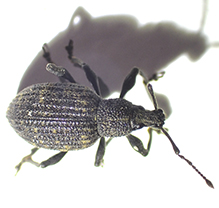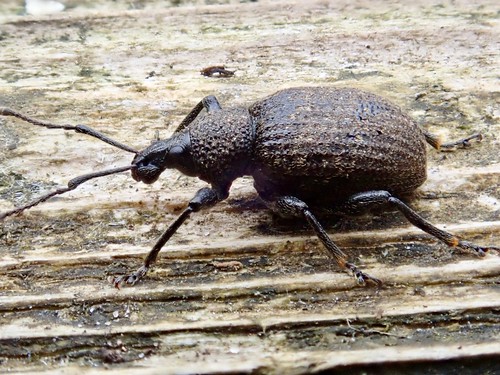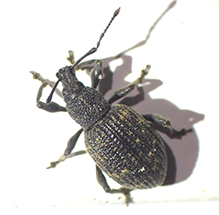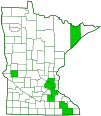black vine weevil
(Otiorhynchus sulcatus)
Conservation • Description • Habitat • Ecology • Distribution • Taxonomy
|
|
||||||||||||||
Description |
Black vine weevil is an exotic, small to medium-sized, broad-nosed weevil. It is native to Europe. It was accidentally introduced into North America, probably in dry ballast from northern Italy. It was first detected in Massachusetts in 1831. It has spread rapidly through the shipment of containerized plants. Warming of the climate has also contributed to its spread and increased abundance. In the United States, it now occurs in most of the contiguous 48 states, but it is absent from the deep south and the Great Plains. The larvae live in the soil and feed on the roots of more than 150 species of plants from many families. They also feed on the cambium at the base of the stem. Adults are active from spring through fall. They are found in the wild but also in greenhouses, flowerpots, parks, orchards, roadside greeneries, and other human-created environments. In greenhouses, they are active year-round. They feed at night on the leaves of an even wider range of plants than the larvae. They feed only on the leaf margins – they do not chew holes in the leaves. They are often first detected by seeing notches in the leaf margins of plants. Black vine weevil is a pest of agricultural crops, including grape vines, citrus trees, and cultivated berries. It is a pest in nurseries, where the roots of plants in containers are restricted and crowded, and where they can feed on and destroy stored corms and bulbs. It is also a pest of garden plants. Adults are ¼″ to ⅜″ (7.0 to 9.5 mm) in length. The body is broad, very convex, and entirely black. It is sparsely covered with pale hairs that lay flat. The head is narrow. The mouthparts are greatly elongated into a snout-like projection of the head (rostrum). The head and rostrum, taken together, is as long as the plate covering the first segment of the thorax (pronotum). The eyes are moderate sized. The antennae are bent (elbowed), and they have 11 segments. The first segment (scape) is very long and is gradually thickened on the outer third. The third segment is much longer than the second or fourth segments. The last three segments are expanded, forming a compact, narrow, pointed club. The rostrum is short and nearly rectangular. There is a shallow depression in the middle between two ridges, and there is a Y-shaped ridge at the tip. On each side of the rostrum there is a groove (scrobe) that holds the bases of the antennae when at rest. The scrobes and antennal bases are visible when viewed from above. At the end of the rostrum, there is a pair of lateral expansions (pterygia) that lie above the scrobes. The rostrum is wider between the pterygia. The description of the rostrum may seem overly technical, but it is useful in distinguishing this species from similar weevils. The pronotum is oval, longer than wide, and rounded on the sides. The upper surface is covered with small, shiny bumps (tubercles). The wing covers (elytra) are broadly oval. Together, they are almost twice the width of the pronotum. Each elytron has several narrow longitudinal grooves. The surface is coarsely pitted (punctate) and it is covered with small shiny tubercles. There are numerous scattered patches of golden scales covered with yellow hairs. The inner margins of the elytra are fused together, and the weevil cannot fly. The legs are long and stout. The third segment (femur) on each leg is smooth, with no tubercles, and there is a small tooth with a single point on the underside. On the front legs, the fourth segment (tibia) broadens toward the tip on the inside but not on the outside. The last part of each leg (tarsus), corresponding to the foot, has five segments, but the fourth segment is small and hidden between the lobes of the third segment, making the tarsus appear to have just four segments. There is a pair of claws at the end of each tarsus. The claws are clearly separated at the base. |
Size |
Total length: ¼″ to ⅜″ (7.0 to 9.5 mm) |
Similar Species |
Habitat |
Wild places, greenhouses, flowerpots, parks, orchards, roadside greeneries, and other human-created environments |
Ecology |
Season |
One generation per year: spring through fall |
Behavior |
Adults feed at night and spend the day in the soil. They often spend the winter hibernating in people’s houses. Since they cannot fly, they can disperse only as far as they can walk. Spread of the species depends on shipments of containerized plants and other horticultural products. |
Life Cycle |
Females reproduce mostly parthenogenetically, meaning that the eggs they lay produce only more females. Fertilization by a male is necessary to produce more males, but to date, no males have been observed in North America. The female lays eggs in soil near the roots of a plant. She may lay more than 800 eggs in her lifetime. Larvae overwinter in the soil. Most adults die in late summer and fall. In warmer areas, a few adults hibernate through the winter and lay eggs in the spring. In the north, adults sometimes hibernate in people’s houses. |
Larva Food |
Roots and cambium of a wide range of herbaceous plants |
Adult Food |
Leaves of a wide range of herbaceous plants |
Distribution |
||
|
Sources |
|
| 2/13/2024 | ||
Occurrence |
||
Common |
||
Taxonomy |
|
Order |
Coleoptera (Beetles) |
Suborder |
Polyphaga (Water, Rove, Scarab, Long-horned, Leaf, and Snout Beetles) |
Infraorder |
Cucujiformia |
Superfamily |
Curculionoidea (snout and bark beetles) |
Family |
Curculionidae (true weevils) |
Subfamily |
Entiminae (broad-nosed weevils) |
Tribe |
Otiorhynchini |
Genus |
Otiorhynchus |
Subordinate Taxa |
|
|
|
Synonyms |
|
Brachyrhinus sulcatus Curculio griseopunctatus Curculio strictus Curculio sulcatus Cryphiphorus sulcatus Otiorhynchus linearis Otiorhynchus pseudolinearis Otiorhynchus sayi Otiorrhynchus sulcatus |
|
Common Names |
|
black vine weevil vine weevil |
|
Glossary
Cambium
A thin layer of soft growing tissue composed of unspecialized cells in the stems of plants. It provides new xylem to the inside and new phloem to the outside.
Elytra
The hardened or leathery forewings of beetles used to protect the fragile hindwings, which are used for flying. Singular: elytron.
Femur
On insects and arachnids, the third, largest, most robust segment of the leg, coming immediately before the tibia. On humans, the thigh bone.
Pronotum
The exoskeletal plate on the upper side of the first segment of the thorax of an insect.
Punctate
Dotted with pits (punctures), translucent sunken glands, or colored spots of pigment.
Rostrum
The stiff, beak-like projection of the carapace or prolongation of the head of an insect, crustacean, or cetacean.
Scape
In plants: An erect, leafless stalk growing from the rootstock and supporting a flower or a flower cluster. In insects: The basal segment of the antenna.
Tarsus
On insects, the last two to five subdivisions of the leg, attached to the tibia; the foot. On spiders, the last segment of the leg. Plural: tarsi.
Tibia
The fourth segment of an insect leg, after the femur and before the tarsus (foot). The fifth segment of a spider leg or palp. Plural: tibiae.
Tubercle
On plants and animals: a small, rounded, raised projection on the surface. On insects and spiders: a low, small, usually rounded, knob-like projection. On slugs: raised areas of skin between grooves covering the body.
Visitor Photos |
||
Share your photo of this insect. |
||
This button not working for you? |
||
Babette Kis |
||
Otiorhynchus sulcatus - Black vine Weevil Otiorhynchus sulcatus, black vine weevil, at the house adjacent to Barnes Prairie, Racine Co., WI. Photos taken on Sept. 10, 2021. |
||
 |
|
|
MinnesotaSeasons.com Photos |
||
|
||
|
||

Slideshows |
Otiorhynchus sulcatus |
 |
About
Otiorhynchus sulcatus, I think |
Otiorhynchus sulcatus |
 |

Visitor Videos |
||
Share your video of this insect. |
||
This button not working for you? |
||
|
Other Videos |
||
nematop® Black vine weevil (Otiorhynchus sulcatus) - biocontrol with nematodes |
About
Mar 18, 2013 e-nema (https://www.e-nema.com) presents: Biological control of the black vine weevil Otiorhynchus sulcatus with the entomopathogenic nematode Heterorhabditis bacteriophora. |
Ciclo de vida | Otiorhynchus sulcatus |
About
Aug 18, 2016 Créditos: Koppert Biological Systems |

Visitor Sightings |
||
Report a sighting of this insect. |
||
This button not working for you? |
||
Babette Kis |
Location: Barnes Prairie, Racine Co., WI Otiorhynchus sulcatus, black vine weevil, at the house adjacent to Barnes Prairie, Racine Co., WI. Photos taken on Sept. 10, 2021. |
 |
MinnesotaSeasons.com Sightings |
||
|

Created: 2/13/2024 Last Updated: © MinnesotaSeasons.com. All rights reserved. |

